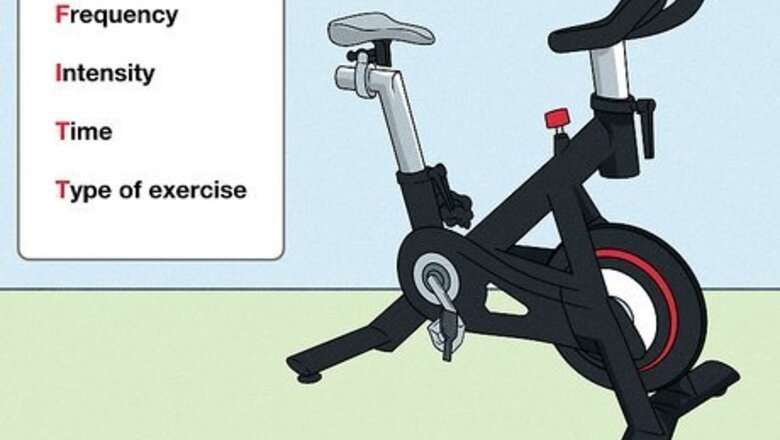
views
Exercising on a Stationary Bike
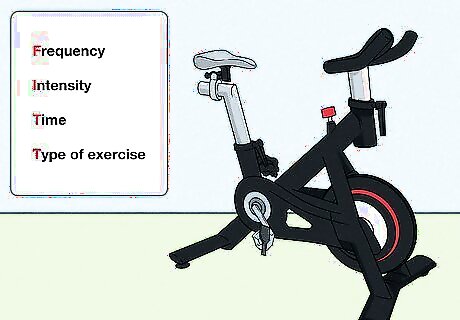
Pace yourself. If you have a new piece of equipment, you may want to leap on and pedal your heart out; however, you'll quickly exhaust yourself if you take this route. Use FITT (Frequency, Intensity, Time, Type of exercise) principles to determine roughly how much exercise you should start with. "F" is for Frequency. If you are new to cardiovascular exercise, you should start out by exercising three to five days a week. If you are experienced, you can exercise anywhere from five to seven days a week. "I" is for Intensity. This is measured in BPM (beats per minute), so you can measure this best if your bike comes with a heart monitor. Figure out your target heart rate so you know what range is safe for you. "T" is for Time. Beginners should try for 20 – 30 minutes a day, while experienced cyclists should aim for 30 – 60 minutes a day. If you have to start with a shorter regimen, that's fine! If you haven't exercised in a long time, 10 minutes might be sufficient to start with. Just keep increasing your time — try staying on the bike five minutes longer each week.
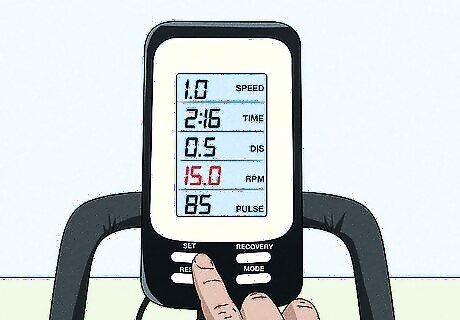
Vary resistance and speed. Your bike's settings may be altered as many times during your workout as you wish. Generally, you should start at a lower speed with less resistance, and increase your effort as you get accustomed to the bike. Toggle between levels of difficulty for a more intense interval workout. Bike speed is usually measured in RPM, revolutions per minute. If you're a beginner, try setting your bike at an average of 60 RPM. With more experience, your average should be more like 80 or 100 RPM. When interval training, try switching between about 50 RPM and 100 RPM. (You should not go above 110 RPM — increase resistance instead if you need more of a challenge). If you find yourself bouncing in the saddle of your bike, this means you are not in control of your pedal stroke and you are going too fast. If you are at a high RPM with too little resistance, your pedals are turning because of the momentum of the weighted flywheel. This means you are not doing the work of pedaling, and you are going at an unsafe, uncontrolled cadence. Your bike likely has low, medium, and high resistance settings. Resistance mimics the effect of incline, so it feels like you are riding uphill. Start with a low resistance, and move into using the medium and high settings as your muscles develop. When you are comfortable using all settings, do interval trainings where you switch between medium and low, with short bursts of high resistance.

Distract yourself cautiously. Listening to music you enjoy can usually help your workout by raising your mood, but other forms of media can potentially slow you down. Watching a highly engaging drama, reading, and texting tend to slow your pace and compromise your posture. If you are reading or watching a screen, make sure it's exactly at eye level so you don't hunch. If you are exercising with a friend, try interval training at the same intervals so you can chat during recovery time.
Maximizing Your Workout with Interval Training
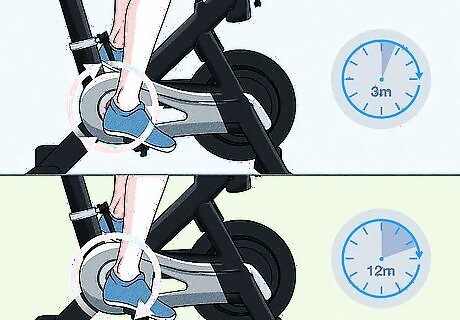
Start with 1:3 or 1:4 interval training. Interval training provides you with the most efficient form of cardiovascular exercise. In interval training, you perform some of your exercise at a high speed, but you mix it up with "recovery" periods, during which you continue to work out at a slower pace. For a 1:4 system, you will exercise at a high speed for three minutes, then a moderate "recovery" speed for 12 minutes. Fit individuals may start with a 1:2 speed-recovery ratio. For example, if your interval time is three minutes, then bike at a leisurely pace for six minutes. When you're comfortable with this, you might switch to a 1:1 ratio, going fast for three minutes, then slowing down for three minutes.
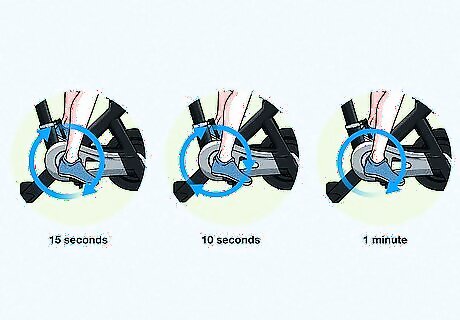
Do a high-intensity workout. Find spin class videos to bike along with online, or find a cycling routine and follow it on your own. It's easy to find examples of high-intensity patterns online, but it can be hard to keep track of them by yourself. Watch the clock, or use a timer. An example routine: warm up for 15 seconds at moderate effort, then pedal hard for 10 seconds, then pedal slowly for one minute. Follow this by pedaling hard for 20 seconds, then pedal slowly for one minute. Next, pedal hard for 30 seconds, then pedal slowly for two minutes. Pedal hard for 10 seconds, standing up on your upright bike if you can. Sit and pedal slowly for two minutes. Pedal hard for 15 seconds, standing up if you can, then sit and pedal slowly for one minute. Pedal hard for 20 seconds, standing, then sit and pedal slowly for two minutes. Ride for another five minutes at the moderate pace you began, then recover at a leisurely pace for a final five minutes.
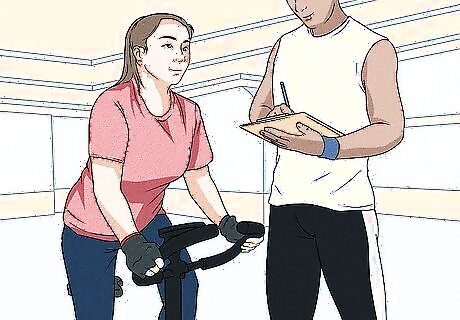
Take a spin class. Check to see if your local gym offers indoor cycling classes. In these classes you will use an upright bike. An instructor will guide you through interval training, urging you to speed up or slow down in order to maximize the efficiency of your workout. Bring earplugs if you're sensitive to noise, as such classes tend to include loud music; however, be sure you let your spin instructor know that you'll be wearing them for safety's sake. Spin classes tend to be about 45 minutes long, and beginners are encouraged to stay on the bike for the full class, but work at their own pace.
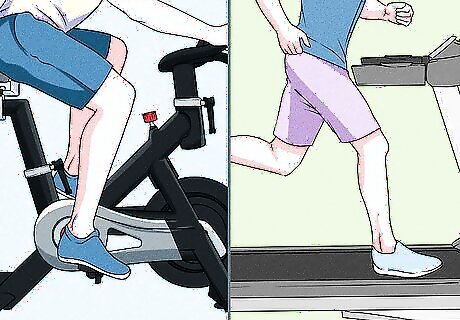
Vary your exercise routine. Interval training is based on the principle of variety—your body will get more of a workout when you fight inertia; however, you'll fall into a rut if you always exercise the same way, even if that same way is itself various. You're more likely to feel happy and continue exercising if you vary your routine, and less likely to injure yourself. Break up your cycling with other cardio machines, such as stair climbers and ellipticals. Start out with interval training at least once a week, then increase the frequency. Over a period of weeks and months you should also increase the intensity of your intervals. Try other forms of exercise, such as brisk walking, dancing, and swimming. EXPERT TIP Laila Ajani Laila Ajani Fitness Trainer Laila Ajani is a Fitness Trainer and founder of Push Personal Fitness, a personal training organization based in the San Francisco Bay Area. With over 10 years as a trainer and exercise specialist, Laila has expertise in competitive athletics (gymnastics, powerlifting, and tennis), personal training, distance running, and Olympic lifting. Laila is certified by the National Strength & Conditioning Association (NSCA), USA Powerlifting (USAPL), and she is a Corrective Exercise Specialist (CES). Laila Ajani Laila Ajani Fitness Trainer Cardio can be fun. Find stimulating ways to make your treadmill workouts more engaging. Create a playlist of your favorite workout songs, watch a show or fitness class while you're on the machine, or try a dance routine from YouTube. To mix things up, switch between cardio machines like the treadmill, bike, rowing machine, and elliptical. Remember, you don't have to stick to traditional cardio exercises. You can also try fun activities like salsa dancing or playing a sport you enjoyed as a child.
Setting Up Your Bike
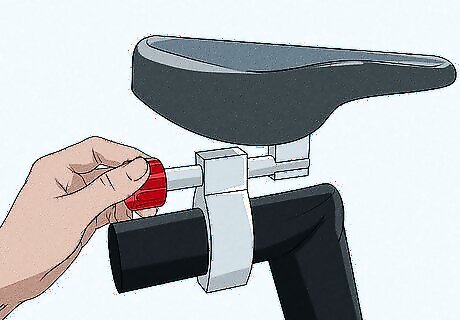
Adjust the seat of your bike. Bring your seat up or down so that it is level with the top of your hipbone. This may be the right height, but you'll need to test it. Mount the bike and put your feet in the pedals. Extend one leg until you have pushed the pedal as far towards the floor as you can. Your knee should still be slightly bent, at approximately a 20 – 30 degree angle. If your knee is bent more than 30 degrees, raise the seat slightly. If your leg is fully extended, lower the seat. Pedal a little. If your pelvis rocks on the seat, lower the seat slightly. Some upright bikes let you move your seat or handlebars forward and backward. Adjust the seat so that the distance between the end of the seat and the middle of the handlebars is that from your elbow to your knuckles. If your knees are not aligned with your ankles when you pedal, or if your arms are not relaxed as you pedal, adjust either the seat or the handlebars. To adjust a recumbent bike, sit in the seat and adjust forwards and backwards until you have one leg extended at a 20 – 30 degree angle. The way you adjust your seat will depend on the model of your bike. Consult your user's manual if you are unsure.
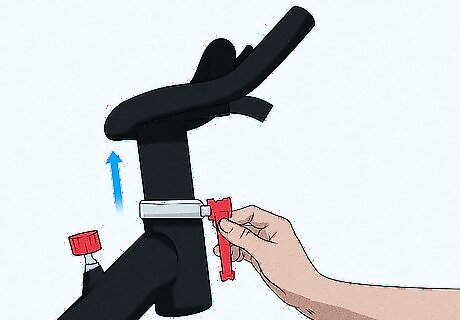
Determine your handlebar height. For upright bikes, you'll need to adjust the handlebars so that you can easily reach them. Your arms should be relaxed, and your elbows slightly bent. If you are hunching your back as you pedal, try raising your handlebars until your back is straight.
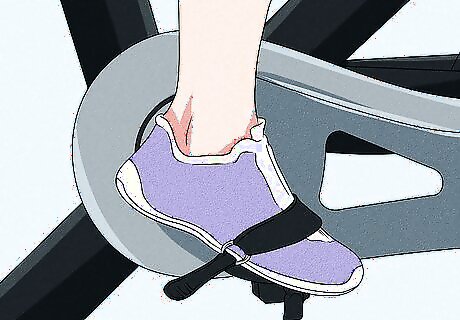
Fasten your foot straps. Sit in your bike seat and place the balls of your feet on the pedals. Adjust the straps so that they grip your foot snugly, but not tightly. Your foot should not slip around within the strap, but it should be able to slide out easily when pulled. Limit ankle movement while you pedal. If you feel that you are pushing or straining your ankles, relax them. Wear your exercise shoes when you make these adjustments.
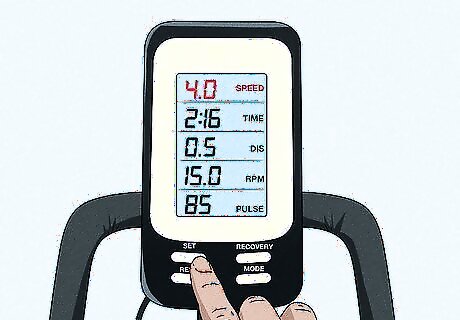
Set the controls on your bike. Your exercise bike will include settings for speed and resistance or incline. Depending on the model, you may also have a set of workout programs, a heart monitor, and other features. Consult your bike manual for instructions specific to your bike's model. Most recumbent bikes offer workout programs. Most bikes will have a "Settings" menu that can be accessed from the console. There may be a button that says "Settings," "Calories," and/or "Menu."




















Comments
0 comment